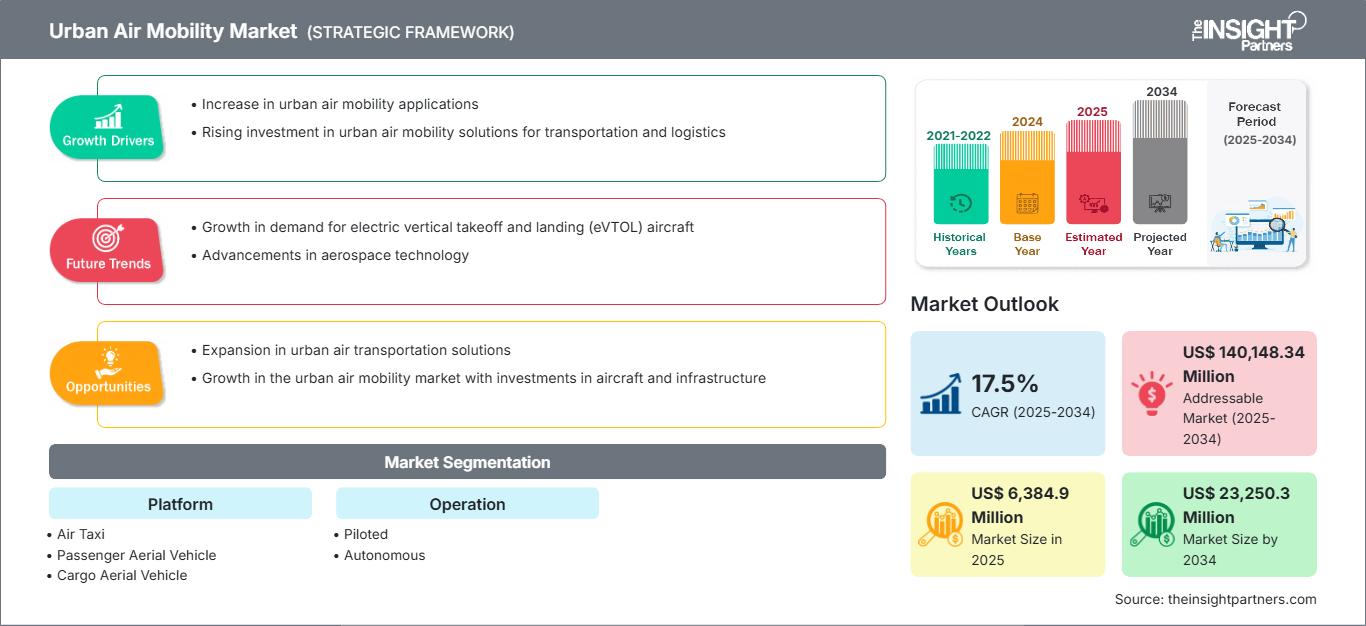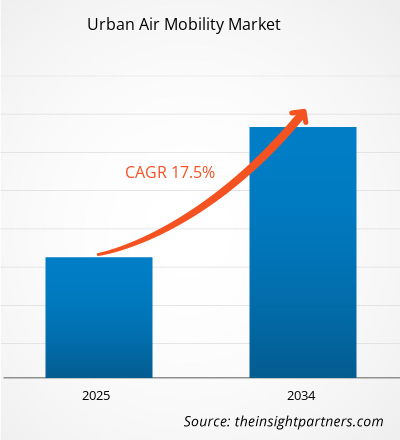都市航空モビリティ市場は、2025年に63億8,490万米ドルに達すると予測されており、2034年までに232億5,030万米ドルに達すると予測されています。また、2025年から2034年の予測期間中に17.5%のCAGRで成長すると見込まれています。
都市航空モビリティの旅客輸送機では、最低3人、最大5~6人の乗客が移動できます。地方では、必要に応じて6人を超える乗客が三輪の旅客輸送機で移動します。都市部の交通渋滞の悪化は、市場の成長を促進する主な要因です。世界の都市人口が増加するにつれて、交通渋滞は人々の生活の質に深刻な影響を与え、経済成長全体に悪影響を及ぼしています。たとえば、INRIX(交通分析会社)によると、米国の通勤者は、渋滞のピーク時に年間約41時間を交通渋滞に費やしています。また、交通渋滞により米国のドライバーは2017年に約3,050億米ドルの損失を被っており、これはドライバー1人あたり平均1,445米ドルに相当します。さらに、米国環境保護庁は、平均的な乗用車が毎年4.7トンの二酸化炭素を排出していると推定しています。さらに、インドや中国などの発展途上国では、自動車の所有率が上昇するとともに、自動車事故も急増しています。世界保健機関(WHO)によると、毎年約125万人が自動車事故で亡くなっており、1日あたり約3,400人が死亡しています。これには、致命的ではない事故で発生した数百万人の負傷者は含まれていません。
世界の都市航空モビリティ市場は、タイプ別に旅客輸送機と貨物輸送機に分類されています。燃料タイプに基づいて、都市航空モビリティ市場はディーゼル、ガソリン、CNG、LPG、電気に分類されています。電動都市航空モビリティの需要の増加、人口の増加、および地域の交通渋滞の緩和に役立つ車両のニーズの増加により、世界の都市航空モビリティ市場の成長が促進されています。
要件に合わせてレポートをカスタマイズ
レポートの一部、国レベルの分析、Excelデータパックなどを含め、スタートアップ&大学向けに特別オファーや割引もご利用いただけます(無償)
都市型航空モビリティ市場: 戦略的洞察

- このレポートの主要な市場動向を入手してください。この無料サンプルには、市場動向から見積もりや予測に至るまでのデータ分析が含まれます。
都市型航空モビリティ市場の洞察:航空技術と自動運転技術の進歩
レポートの一部、国レベルの分析、Excelデータパックなどを含め、スタートアップ&大学向けに特別オファーや割引もご利用いただけます(無償)
都市型航空モビリティ市場: 戦略的洞察

- このレポートの主要な市場動向を入手してください。この無料サンプルには、市場動向から見積もりや予測に至るまでのデータ分析が含まれます。
航空技術の進歩により、大都市圏の人や貨物に便利で効率的なオンデマンド輸送を提供できる可能性が生まれています。都市型航空モビリティ(UAM)は、社会の移動性を再構築する可能性を秘めた輸送コンセプトです。非常に手頃な価格で、アクセスしやすく、高速な都市型航空輸送を提案し、既存の道路輸送インフラの負荷を軽減することで地上の混雑を緩和します。UAMは、分散型電気推進などの技術の進歩、アプリケーションベースのライドシェアリングなどの新しいビジネスモデル、生産コストを削減する先進航空宇宙製造のトレンドに依存しています。車両の自動化と自律走行車の運用の信頼性を高めることは、自律型UAMビジョンの実現に不可欠です。予想される高い需要に対応できる、経済的に実現可能な輸送システムには、自律性が不可欠です。安定性、機動性、垂直離着陸(VTOL)機の技術的成熟度の飛躍的な向上と高度自動飛行が、UAM業界を牽引する主な要因となるでしょう。
プラットフォームベースの市場分析
都市型航空モビリティ市場は、プラットフォームに基づいて、エアタクシー、旅客機、貨物機、救急ヘリコプターに分かれています。UAMは、貨物だけでなく人間の輸送も容易かつ迅速に行うため、幅広い用途で利用されています。これらのUAMは、小物品や医療品の輸送に広く利用されているほか、旅客輸送にも利用されています。しかし、これらのモビリティソリューションには、用途に応じて飛行制限があります。UAMは、中規模および高層ビルに衝突する可能性があるため低速飛行は許可されておらず、航空会社に衝突する可能性があるため高速飛行も許可されていません。
運用ベースの市場分析
都市型航空モビリティ市場は、運用に基づいて、有人飛行と自律飛行に分かれています。自律型eVTOLは貨物および旅客輸送に適しており、都市間輸送での活用が拡大すると予想されるため、予測期間中は自律型セグメントが市場をリードすると見込まれています。
都市型航空モビリティ市場で事業を展開するプレーヤーは、市場イニシアチブ、買収、製品発売などの戦略に焦点を当て、都市型航空モビリティ市場での地位を維持しています。都市型航空モビリティ市場の主要プレーヤーによる開発の一部を以下に示します。
2020年2月、エアバスとシンガポール民間航空局は、シンガポールで都市型航空モビリティを実現するための覚書を締結しました。この協力により、シンガポールにおける都市型航空モビリティが実現します。
2019年2月、Airspace Experience Technologiesは、Spirit AeroSystemsと、認定された全電動垂直離着陸(eVTOL)航空機の製造について正式契約を締結しました。
都市型航空モビリティ市場の地域別分析
予測期間全体を通して都市型航空モビリティ市場に影響を与える地域的なトレンドと要因については、The Insight Partnersのアナリストが詳細に解説しています。このセクションでは、北米、ヨーロッパ、アジア太平洋、中東・アフリカ、中南米における都市型航空モビリティ市場のセグメントと地域についても解説しています。
都市航空モビリティ市場レポートの範囲
| レポート属性 | 詳細 |
|---|---|
| の市場規模 2025 | US$ 6,384.9 Million |
| 市場規模別 2034 | US$ 23,250.3 Million |
| 世界的なCAGR (2025 - 2034) | 17.5% |
| 過去データ | 2021-2022 |
| 予測期間 | 2025-2034 |
| 対象セグメント |
By プラットフォーム
|
| 対象地域と国 | 北米
|
| 市場リーダーと主要企業の概要 |
|
都市型航空モビリティ市場のプレーヤー密度:ビジネスダイナミクスへの影響を理解する
アーバンエアモビリティ市場は、消費者の嗜好の変化、技術の進歩、製品メリットへの認知度の向上といった要因によるエンドユーザーの需要増加に牽引され、急速に成長しています。需要の増加に伴い、企業は製品ラインナップの拡充、消費者ニーズへの対応のためのイノベーション、そして新たなトレンドの活用を進めており、これが市場の成長をさらに加速させています。

- 入手 都市型航空モビリティ市場 主要プレーヤーの概要
- エアタクシー
- 旅客航空機
- 貨物航空機
- 救急ヘリコプター
都市航空モビリティ市場 - 運用別
- 有人
- 自律型
都市航空モビリティ市場 -地域別
北米
- 米国
- カナダ
ヨーロッパ
- フランス
- ドイツ
- 英国
- ロシア
- その他ヨーロッパ
その他世界
都市型航空モビリティ市場 – 企業プロファイル
- エアバスSAS
- Aurora Flight Sciences
- ベル・ヘリコプター・テキストロン社
- EHang
- エンブラエルX
- ハネウェル・インターナショナル社
- キティホーク
- ムーグ社
- Volocopter GmbH
- 過去2年間の分析、基準年、CAGRによる予測(7年間)
- PEST分析とSWOT分析
- 市場規模価値/数量 - 世界、地域、国
- 業界と競争環境
- Excel データセット
最新レポート
関連レポート
お客様の声
購入理由
- 情報に基づいた意思決定
- 市場動向の理解
- 競合分析
- 顧客インサイト
- 市場予測
- リスク軽減
- 戦略計画
- 投資の正当性
- 新興市場の特定
- マーケティング戦略の強化
- 業務効率の向上
- 規制動向への対応




















 無料サンプルを入手 - 都市型航空モビリティ市場
無料サンプルを入手 - 都市型航空モビリティ市場